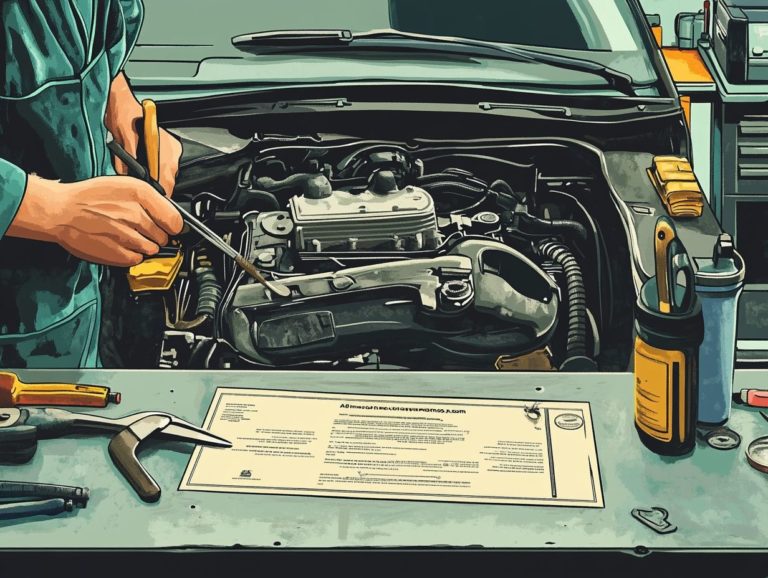How to Prepare for a Warranty Inspection
Warranty inspections are an essential step in safeguarding your investment. They offer a valuable chance to pinpoint and resolve any issues with your property before the warranty period comes to an end.
Get ready to protect your investment! This guide provides a breakdown of what a warranty inspection involves, effective preparation strategies, and what you can expect on inspection day.
It highlights common areas of focus, offers advice on how to communicate with your inspector, and shares tips for addressing any concerns that may arise.
Whether you re a first-time homeowner or a seasoned buyer, this information will empower you to navigate the warranty inspection process with confidence and ease.
Contents
- Key Takeaways:
- Understanding Warranty Inspections
- Preparing for a Warranty Inspection
- What to Expect During the Inspection
- Addressing Any Issues Found
- Tips for a Successful Warranty Inspection
- Frequently Asked Questions
- What is a warranty inspection and why is it important?
- How can I prepare for a warranty inspection?
- What should I expect during a warranty inspection?
- Can I be present during the warranty inspection?
- What happens after the warranty inspection?
- What if I disagree with the results of the warranty inspection?
Key Takeaways:

- Understand the purpose of a warranty inspection and its role in protecting your investment.
- Gather all necessary documents and ensure proper maintenance to demonstrate compliance with warranty terms.
- Be aware of common areas inspected. Communicate openly with the inspector. Address any issues found by negotiating with the builder/manufacturer and taking timely action.
Understanding Warranty Inspections
Understanding warranty inspections is essential for you as a homeowner, especially in regions like Maryland, Virginia, and DC. A careful check-up can safeguard your investment in a new home.
A home warranty acts as a protective cushion, covering significant repairs and maintenance issues that may arise after your purchase, particularly if your property is still under a builder warranty.
By getting to know the inspection process, you can spot common defects and ensure that professional inspectors carry out thorough evaluations, thus protecting your rights as a homeowner.
What is a Warranty Inspection?
A warranty inspection is a thorough examination of your home, designed to evaluate its condition and pinpoint any significant maintenance issues or common defects that may fall under your home warranty.
This crucial process aims to protect your investment by uncovering potential problems before they escalate into costly repairs. Typically, these inspections delve into essential systems like HVAC (Heating, Ventilation, and Air Conditioning), plumbing, and electrical, as well as structural components such as roofing, foundations, and windows.
By catching issues early whether it s a leaky pipe or faulty wiring you can leverage your warranty provisions, sidestepping the financial strain of major repairs. Engaging a qualified inspector grants you peace of mind and helps maintain the overall integrity and value of your property.
Preparing for a Warranty Inspection
Preparing for a warranty inspection is crucial for homeowners who want to fully leverage the advantages of their home warranty. Ensure that every aspect is thoroughly evaluated.
By adhering to a comprehensive inspection checklist and fostering homeowner cooperation, you can effectively showcase any recent repairs or maintenance concerns that might influence the inspection results.
Prepare by ensuring ample lighting and easy access to different areas of your home. This not only simplifies the inspector’s task but also promotes a thorough and accurate assessment.
Gathering Necessary Documents
Gathering the necessary documents is a crucial step in preparing for a warranty inspection. This provides the inspector with vital information about your home warranty and any builder warranty that might still be in effect.
To ensure a comprehensive evaluation, compile essential documents such as the original home warranty agreement, which outlines coverage specifics and terms. Don’t forget to include details about any builder warranty, as these can often be time-sensitive and significantly impact repairs or replacements.
It’s also wise to gather maintenance records that demonstrate the upkeep and repairs you’ve performed on various components of your home. This documentation aids the inspector in assessing your property’s condition and streamlines any claims that may arise during the inspection process, ensuring potential issues are addressed swiftly and effectively.
Ensuring Proper Maintenance

Ensuring proper maintenance of your home is essential for maximizing the benefits of your home warranty. Neglecting crucial areas such as plumbing fixtures, HVAC systems, and electrical outlets can lead to expensive repairs that might not be covered by your warranty.
To effectively protect yourself against unexpected costs, it s important to adopt regular check-up routines and address any minor issues without delay. Simple practices like changing air filters monthly and inspecting plumbing for leaks can significantly enhance system longevity.
You should also document your maintenance activities to demonstrate diligence when a warranty claim arises. By integrating these strategies into your daily routines, you not only extend the life of your home systems but also enjoy peace of mind, knowing you re maximizing your warranty coverage.
What to Expect During the Inspection
During a warranty inspection, expect a careful evaluation conducted by a professional inspector. They will assess various common areas for defects and maintenance issues, highlighting the significance of your cooperation throughout the process.
This collaborative approach ensures that all critical systems from plumbing to roofing are thoroughly examined. This gives you a complete understanding of your home’s condition.
Common Areas Inspected
During a warranty inspection, common areas under scrutiny include critical systems. These systems HVAC, plumbing, electrical, the foundation, and the roof are essential for maintaining your home’s integrity.
Each of these systems plays a vital role in your safety and comfort. HVAC systems, for example, do more than keep the temperature cozy; they also help maintain healthy indoor air quality.
Inspectors carefully check these systems for any signs of wear, leaks, or inefficiencies that could lead to expensive repairs down the line.
Plumbing inspections focus on identifying leaks and water pressure issues, as well as the condition of pipes. This helps prevent potential water damage and mold growth.
For electrical systems, inspectors look for outdated wiring or overloaded circuits, which can pose serious fire hazards.
The foundation is the backbone of your home. Inspectors will check for cracks or signs of shifting that may indicate underlying issues. Inspectors also thoroughly examine roofs for wear, leaks, or missing shingles that could compromise your home s defense against the elements.
Communication with the Inspector
Effective communication with your professional inspector is crucial for a successful warranty inspection. It ensures that all your concerns are addressed and that the inspection checklist is meticulously followed.
This conversation doesn t just start and end on the day of the inspection; it highlights the importance of preparatory discussions. Before the inspector arrives, make sure to list your top concerns to get the most out of the process!
During the inspection, feel entirely at ease asking questions and clarifying procedures. This collaborative approach not only enhances the inspector s understanding but also builds trust, leading to a thorough and transparent evaluation.
By maintaining an open line of communication, you can gain valuable insights that help preserve your property’s integrity and ensure you re well-informed throughout the entire process.
Addressing Any Issues Found
Addressing issues identified during a warranty inspection is essential for homeowners who wish to protect their investment. This process often requires engaging in negotiations with the builder or manufacturer to secure necessary repairs or replacements that may fall under the warranty coverage.
Taking these steps ensures that your home remains in optimal condition and your investment is well-protected.
Negotiating with the Builder/Manufacturer

Negotiating with the builder or manufacturer after an inspection can feel overwhelming, but it s a crucial step to ensure necessary repairs are made according to the warranty agreement.
To navigate this complex terrain effectively, understanding your warranty helps you communicate confidently. Familiarize yourself with the specific warranty provisions that apply to your situation.
Documenting any issues complete with photographs and written correspondence becomes invaluable evidence during your discussions. It s essential to maintain professionalism. Being assertive yet courteous can pave the way for more productive negotiations.
By fostering a collaborative dialogue, you have the opportunity to build rapport with the builder or manufacturer, significantly increasing the chances of a favorable resolution to your concerns.
Taking Action on Repairs or Replacements
Taking action on repairs or replacements identified during the warranty inspection is essential for protecting your home. Addressing both minor repairs and serious issues like water damage is crucial.
Act quickly on any needed repairs to prevent further damage! By promptly tackling these concerns, you not only safeguard your property but also potentially save yourself from more extensive costs down the line that could arise from neglect.
When faced with a repair, your first step should be to document the problem thoroughly; photographs and detailed notes will prove invaluable later on.
Next, reach out to a trusted contractor for an evaluation of the situation. Their professional assessment will ensure that you take the appropriate course of action whether that involves a repair or a full replacement.
Utilizing your home warranty can further streamline this process, as it may cover specific repairs or connect you with qualified service professionals. By leveraging these benefits, you can effectively maintain your residence, granting yourself peace of mind.
Tips for a Successful Warranty Inspection
To guarantee a successful warranty inspection, you should prioritize careful preparation, effective communication, and a positive attitude. These elements are very important in shaping the inspection’s outcomes and enhancing your overall experience.
Preparing in Advance
Preparing for a warranty inspection is all about being proactive. Start by crafting a comprehensive inspection checklist and ensuring that every area is well-lit. For more insights, check out the best practices for maintaining warranty coverage. Good lighting makes a big difference for the inspector as they conduct their thorough assessments.
Gather all relevant documents, such as warranty paperwork, maintenance records, and previous inspection reports. Keeping these easily accessible will save you time and stress.
Organizing them in a designated folder can help streamline the process, ensuring nothing slips through the cracks during the inspection. Don t forget to provide clear access to key areas of your home, such as the attic, basement, and utility spaces.
Remove any obstacles that might hinder the inspector s ability to perform their work efficiently. By taking these thoughtful steps, you can make the entire inspection process smoother, leading to a more effective evaluation.
Maintaining a Positive Attitude
Maintaining a positive attitude during the warranty inspection can significantly influence the entire process. It fosters better communication and cooperation between you and the inspectors.
When you approach the inspection with an open mind, you re more likely to engage in helpful conversation, facilitating an effective exchange of ideas and concerns.
This encourages inspectors to delve deeper into their assessments, while you feel empowered to voice your needs and expectations. A positive mindset not only alleviates anxiety but also creates an atmosphere where inspectors can clearly explain their findings, fostering a sense of partnership.
Ultimately, when you manage emotions well, it cultivates trust, laying the groundwork for improved collaboration and enhanced outcomes throughout the inspection process.
Frequently Asked Questions

Got more questions? Reach out to your warranty provider today!
What is a warranty inspection and why is it important?
A warranty inspection checks the condition and functionality of a product or property covered under warranty. This process confirms that everything meets the agreed standards and helps find any issues before the warranty expires.
How can I prepare for a warranty inspection?
Gather all your warranty documents. Then, clean and maintain the product or property to ensure it’s in great shape.
Fix any known problems ahead of time to avoid complications during the inspection.
What should I expect during a warranty inspection?
Expect the inspector to look over the product or property closely. They may also run tests and ask about any past issues or repairs.
The inspection usually takes a few hours.
Can I be present during the warranty inspection?
Yes! It’s a good idea to be present during the inspection. You can ask questions and see the condition of your product or property directly.
What happens after the warranty inspection?
After the inspection, the professional will give you a detailed report of what they found and suggest any necessary repairs.
If no major issues arise, your warranty continues as usual. If there are problems, the warranty provider will guide you on the next steps.
What if I disagree with the results of the warranty inspection?
If you don t agree with the inspection results, ask for a second opinion or appeal to your warranty provider.
Make sure to have all necessary documents to support your case. If things can’t be resolved, you might need legal help.




